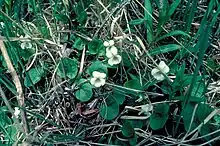Viola renifolia
Viola renifolia is a species of violet known by the common names white violet and kidneyleaf violet. It is native to northern North America, where it has a widespread distribution across Canada and the northern United States as far south as Washington, Colorado, and New York.[1]
| Viola renifolia | |
|---|---|
 | |
| Scientific classification | |
| Kingdom: | Plantae |
| Clade: | Tracheophytes |
| Clade: | Angiosperms |
| Clade: | Eudicots |
| Clade: | Rosids |
| Order: | Malpighiales |
| Family: | Violaceae |
| Genus: | Viola |
| Species: | V. renifolia |
| Binomial name | |
| Viola renifolia | |
Kidneyleaf violet is a perennial herb growing up to 10 centimeters tall. It does not have stems, rhizomes, or stolons. The kidney-shaped leaf blades are 3 to 6 centimeters long and are borne on petioles up to 15 centimeters long. The flower is 1 to 1.5 centimeters long and white in color with purple lines on the lower three petals. The fruit is a purplish capsule.[1][2]
This violet grows in white spruce and black spruce forests, and temperate coniferous forests. Near the Great Lakes it grows in swamps and wooded areas.[1]
Conservation status in the United States
It is listed as endangered in Connecticut, [3] as threatened in Iowa, as extirpated in Pennsylvania, and as sensitive in Washington. [4]
References
- Williams, Tara Y. (1990). "Viola renifolia". Fire Effects Information System (FEIS). US Department of Agriculture (USDA), Forest Service (USFS), Rocky Mountain Research Station, Fire Sciences Laboratory.
- "Viola renifolia". The Nature Conservancy.
- "Connecticut's Endangered, Threatened and Special Concern Species 2015" (PDF). State of Connecticut Department of Energy and Environmental Protection Bureau of Natural Resources. Retrieved 28 March 2018. (Note: This list is newer than the one used by plants.usda.gov and is more up-to-date.)
- "Plants Profile for Viola renifolia (white violet)". plants.usda.gov. Retrieved 24 September 2018.
External links
